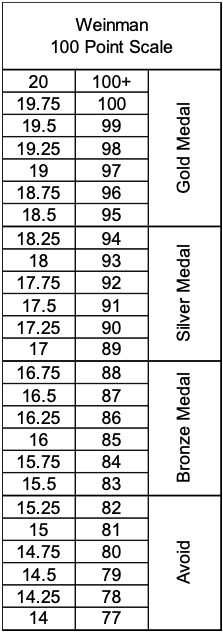Weinman 100 Point Scale for Wine Assessment
Barry Weinman: 10th November 2020

Wine judges have traditionally assessed wines on a 20-point scale, with 3 points allocated to colour, 7 points to aroma and 10 points to flavour/texture.
Whilst a number of major wine competitions still use the 20-point scale, most wine writers and some competitions have adopted the 100-point scale.
The 100-point scale was made famous by USA wine critic Robert Parker, who shot to fame in the 1980’s with his assessment of the 1982 Bordeaux vintage, which other observers had overlooked.
I avoided moving, in part, because there was no clear definition of how the points translated. For most, 95/100 is equal to 18.5/20, the cut off for a gold medal. But there is no logical progression.
96 equates to 19/20 for example. 19 is a score that I reserve for the world’s greatest wines, yet this is a score that many Sauvignon Blancs and Rosés have achieved in recent years from some of the more esteemed critics. This seems overly generous to me.
Perhaps it is because, in effect, they have different scales for different wines. So a 96-point Rosé would not be of the same absolute quality as a 96-point Cabernet. (In my opinion, no Rosé can compete with the best wines made from Chardonnay, Cabernet, Shiraz etc).
Or perhaps they don’t taste blind, allowing the label and maker to influence their points.
To allow me to move to the 100-point scale, I needed to adopt a system that acknowledged the currently used scale, so that readers could compare my points with other critics yet had a logical points transition.
I have anchored the scale on 95 representing a gold medal (18.5/20). However, I added a more linear numerical progression.
To allow me to move in 0.25 increments on the 20-point scale, a score of 100 is equal to 19.75/20. This does not bother me greatly, as I have never given a wine a perfect score.
Cheers
Barry Weinman
